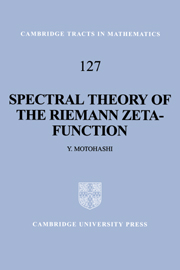
-
Select format
-
- Publisher:
- Cambridge University Press
- Publication date:
- November 2011
- September 1997
- ISBN:
- 9780511983399
- 9780521445207
- 9780521058070
- Dimensions:
- (228 x 152 mm)
- Weight & Pages:
- 0.455kg, 240 Pages
- Dimensions:
- (228 x 152 mm)
- Weight & Pages:
- 0.396kg, 240 Pages
- Subjects:
- Mathematics (general), Mathematics, Number Theory
- Series:
- Cambridge Tracts in Mathematics (127)
You may already have access via personal or institutional login- Subjects:
- Mathematics (general), Mathematics, Number Theory
- Series:
- Cambridge Tracts in Mathematics (127)
Book description
The Riemann zeta function is one of the most studied objects in mathematics, and is of fundamental importance. In this book, based on his own research, Professor Motohashi shows that the function is closely bound with automorphic forms and that many results from there can be woven with techniques and ideas from analytic number theory to yield new insights into, and views of, the zeta function itself. The story starts with an elementary but unabridged treatment of the spectral resolution of the non-Euclidean Laplacian and the trace formulas. This is achieved by the use of standard tools from analysis rather than any heavy machinery, forging a substantial aid for beginners in spectral theory as well. These ideas are then utilized to unveil an image of the zeta-function, first perceived by the author, revealing it to be the main gem of a necklace composed of all automorphic L-functions. In this book, readers will find a detailed account of one of the most fascinating stories in the development of number theory, namely the fusion of two main fields in mathematics that were previously studied separately.
Reviews
Review of the hardback:‘… gives an excellent presentation of the interplay between the Riemann zeta function and automorphic forms … nicely written and of great interest for any number theorists.’
R. Tichy Source: International Mathematical News
Contents
Metrics
Altmetric attention score
Full text views
Full text views help Loading metrics...
Loading metrics...
* Views captured on Cambridge Core between #date#. This data will be updated every 24 hours.
Usage data cannot currently be displayed.
Accessibility standard: Unknown
Why this information is here
This section outlines the accessibility features of this content - including support for screen readers, full keyboard navigation and high-contrast display options. This may not be relevant for you.
Accessibility Information
Accessibility compliance for the PDF of this book is currently unknown and may be updated in the future.


